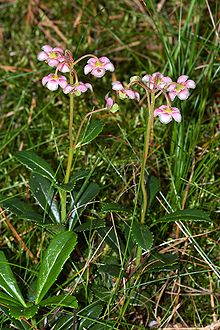bio.wikisort.org - Plant
Chimaphila umbellata, the umbellate wintergreen, pipsissewa, or prince's pine, is a small perennial flowering plant found in dry woodlands, or sandy soils. It is native throughout the cool temperate Northern Hemisphere.
It grows 10–35 cm tall, and has evergreen shiny, bright green, toothed leaves arranged in opposite pairs or whorls of 3–4 along the stem. Leaves have a shallowly toothed margin, where the teeth have fine hairs at their ends. The flowers are white or pink, produced in a small umbel of 4–8 together.
Ecology

Although it has green leaves year-round, it receives a significant portion of its nutrition from fungi in the soil (that is, it is a partial myco-heterotroph, which is not surprising as related plants, such as Pyrola, are partial or full myco-heterotrophs).[1]
Taxonomy

There are four subspecies:
- Chimaphila umbellata subsp. umbellata – Europe, Asia
- Chimaphila umbellata subsp. acuta – southwestern North America
- Chimaphila umbellata subsp. cisatlantica – northeastern North America
- Chimaphila umbellata subsp. occidentalis – northwestern North America
Uses
Some Plateau Indian tribes used a boil of prince's pine to treat tuberculosis.[2]
The twentieth century Appalachian folk healer Clarence "Catfish" Gray, "Man of the Woods", credited pipsissewa with curing his own heart problems and included it in his 15 herb cure-all "bitters."[3]
It is used as a flavoring in candy and soft drinks, particularly root beer.
The roots and leaves of Chimaphila umbellata can be boiled to create tea.[4]
Recent investigations show the anti-proliferative effect of Chimaphila umbellata in human breast cancer cells (MCF-7). [5]
Name
"Pipsissewa" is a Cree name meaning "It-breaks-into-small-pieces".
References
- Leho Tedersoo; Prune Pellet; Urmas Kõljalg; Marc-André Selosse (March 2007). "Parallel evolutionary paths to mycoheterotrophy in understorey Ericaceae and Orchidaceae: ecological evidence for mixotrophy in Pyroleae". Oecologia. 151 (2): 206–217. Bibcode:2007Oecol.151..206T. doi:10.1007/s00442-006-0581-2. PMID 17089139. S2CID 12529846.
- Hunn, Eugene S. (1990). Nch'i-Wana, "The Big River": Mid-Columbia Indians and Their Land. University of Washington Press. p. 352. ISBN 978-0-295-97119-3.
- Green, E. (1978). "A Modern Appalachian Folk Healer". Appalachian Journal. 6 (1): 2–15.
- Patterson, Patricia A. (1985). Field Guide to the Forest Plants of Northern Idaho (PDF). United States Department of Agriculture Forest Service. p. 37-47.
- Das, N., Samantaray, S., Ghosh, C., Kushwaha, K., Sircar, D. and Roy, P., 2021. Chimaphila umbellata extract exerts anti-proliferative effect on human breast cancer cells via RIP1K/RIP3K-mediated necroptosis. Phytomedicine Plus, p.100159.
- Blanchan, Neltje (2005). Wild Flowers Worth Knowing. Project Gutenberg Literary Archive Foundation.
External links
- Flora Europaea: Chimaphila umbellata distribution
- linnaeus.nrm.se: range map with the different subspecies of the Chimaphila umbellata-complex
- Jepson Manual treatment – Chimaphila umbellata
- USDA Plants Profile: Chimaphila umbellata
На других языках
- [en] Chimaphila umbellata
[es] Chimaphila umbellata
Chimaphila umbellata, comúnmente conocida como quimafila o quimáfila, es una pequeña planta perenne que se encuentra en bosques secos o templados del hemisferio norte.[ru] Зимолюбка зонтичная
Зимолю́бка зо́нтичная (лат. Chimáphila umbelláta) — многолетнее зимнезелёное растение, вид рода Зимолюбка (Chimaphila) семейства Вересковые (Ericaceae).Другой контент может иметь иную лицензию. Перед использованием материалов сайта WikiSort.org внимательно изучите правила лицензирования конкретных элементов наполнения сайта.
WikiSort.org - проект по пересортировке и дополнению контента Википедии

